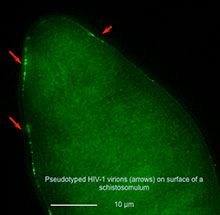
WASHINGTON (Oct. 20, 2016) — A modified form of the HIV-1 virus can integrate into the genome of the parasitic flatworm that causes the disease schistosomiasis, according to a new study published in PLOS Pathogens. This finding could aid research not only into potential new treatments for schistosomiasis and related neglected tropical diseases, but also into virology of HIV.
Schistosomiasis afflicts more than 200 million people worldwide, mostly in developing countries. To improve the existing medication for schistosomiasis, researchers hope to develop new treatments that target key genes in the parasite. However, a complex life cycle makes parasitic flatworms difficult to maintain in a lab, thwarting efforts to determine the function of specific genes.
Sutas Suttiprapa, Ph.D., postdoctoral scientist, Paul Brindley, Ph.D., professor, both in the Department of Microbiology, Immunology, and Tropical Medicine at the George Washington University School of Medicine and Health Sciences, and colleagues are working towards new methods to elucidate gene function by manipulating the genomes of parasitic flatworms.
In their new study, the researchers infected Schistosoma mansoni, a major species of schistosomiasis-causing flatworm, with a strain of HIV-1 whose outer shell had been modified to aid infection. Next-generation DNA sequencing revealed that HIV-1 genetic material had integrated itself throughout the parasitic genome, including in sex chromosomes. This is the first demonstration of HIV-1 integration into the genome of an invertebrate.
The team had previously found that another mammalian retrovirus called MLV could integrate into the parasitic flatworm genome, but only in dividing cells. HIV-1 can integrate into non-dividing cells, which could provide an advantage in studies of gene function at various life stages.
In the future, the research team will attempt to infect S. mansoni eggs with the same modified HIV-1 virus in order to create a line of flatworms that can pass down virus-derived genomic integrations to their offspring. This could open up the possibility of using virus-based methods to block expression of specific flatworm genes, reveal their function and affect viability and fertility of the worms.
“The report,” the authors explain, “reveals that HIV-1 is active with cells of schistosomes, causative agent of the major neglected tropical disease schistosomiasis. The report also demonstrated, for the first time, the integration of HIV-1 into the chromosomes of an invertebrate.”
--
This Press Release is posted courtesy of PLOS.


